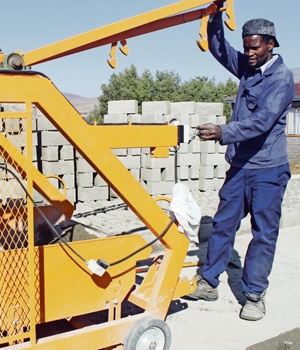
Would you rather have a business with a turnover of R5 million and R100 000 profit, or a business with a turnover of R500 000 and R200 000 profit? A successful business is one that makes its owner a profit, writes Maya Fisher-French.
Simon wrote to City Press to find out whether or not his business was making a profit after six months. This may seem like an obvious answer but the reality is that increasing turnover doesn’t necessarily result in increased profit if you have not priced your product correctly.
It may be difficult to see your profitability in the beginning when you keep ploughing money back into the business – your business starts demanding more inputs to meet the increased demand, so at what stage do you know if you are actually making real money?
Simon’s block-making business based in Witsieshoek in the Free State has been running for six months. “I suspect my over-heads are high and I can’t bring them down, mainly because I don’t have transport of my own,” writes Simon.
His bricks sell for R8.60 each which he believes is the correct price for the market. “How can I make a profit without increasing the price as I want to help the poor to afford building houses?”
Simon supplied a break-down of his costs to produce 580 bricks which takes approximately two days. Based on the information, lecturer for the entrepreneur programme at the Gordon Institute of Business Science, Brian Simelane, calculated the following:
Based on these costs Simon is making a profit on his bricks. Simelane points out that he may however be missing other input costs such as water and the cost of delivery to the customer unless the customer covers this cost
This also assumes that Simon is able to produce about 300 bricks every day. Due to water and electricity shortages, there are several days when Simon is unable to produce bricks and still has to pay staff and his own costs. He needs to build this into his profitability spreadsheet.
Sanjeev Orie, CEO of FNB Business Value Adds, says Simon also needs to do some competitor analysis.
“Find out how much others are charging per brick. Maybe his customers are very happy with the price because he is the cheapest in the market, but this is not sustainable if one is not making a profit.”
Simelane says Simon must try to maximise profit while not losing customers or market share. For example, Simelane calculated that by increasing the price of the bricks to R8.80 (a 2.3% increase), Simon would realise an 8.6% increase in profit – instead of R1 345 per 580 bricks, he’d make R1 461.
“That is additional money that improves cash flow and also helps to build the business further,” says Simelane, who adds that Simon must not just focus on low prices as the only value he can offer his customers.
By focusing on his service, quality and consistency of delivery, customers would be willing to pay a little bit more, improving his profitability and allowing him to build his business.
Simon is on to a good product that meets the demand of his community, but he needs to find ways to increase his production, which includes reliable transportation, water storage and possibly a generator to produce electricity. He would require funding to meet these needs and this could eat into his current profitability. If Simon decides he needs to borrow money to fund these expenses, he must first calculate whether or not the business can sustain the repayment. If he can deliver an uninterrupted supply of bricks and has willing customers, he could generate sufficient profit to cover the repayments – but he needs to do his calculations carefully.
Ways to reduce costs
Donna Rachelson of Seed Academy says Simon could look at optimising his costs through labour and discounts in raw materials.
“This is a business that not only uses material but labour too,” says Rachelson, who suggests that Simon find ways to incentivise labour to be more productive and achieve the best results. As his business grows, he could also get volume discounts for raw materials, which will also drive down costs.
Orie suggests that Simon offer a lower price to customers who collect the bricks. “He will avoid having to pay delivery costs, which he says is hurting him.”




 Publications
Publications
 Partners
Partners








